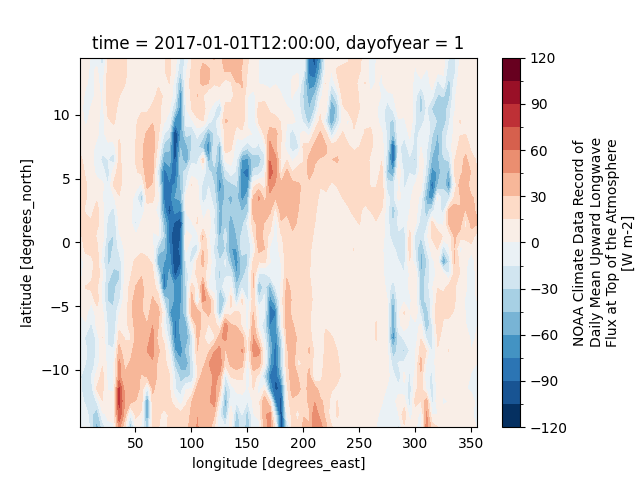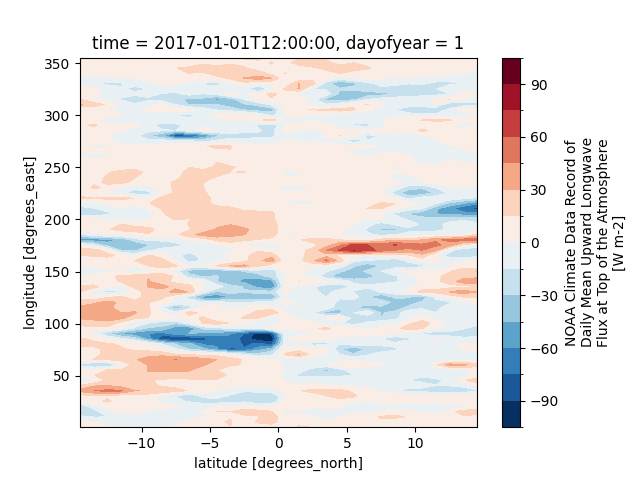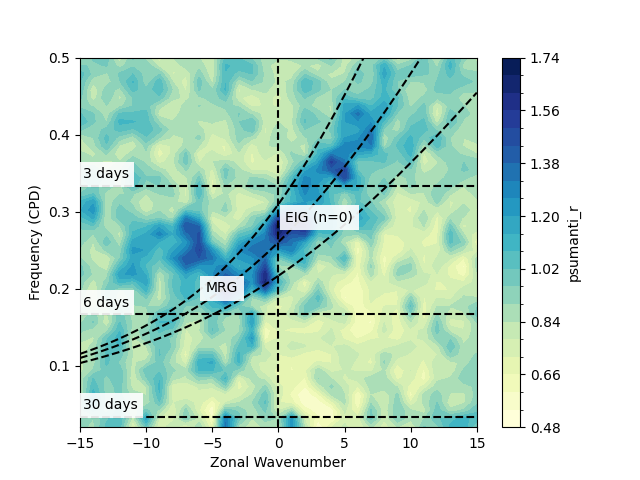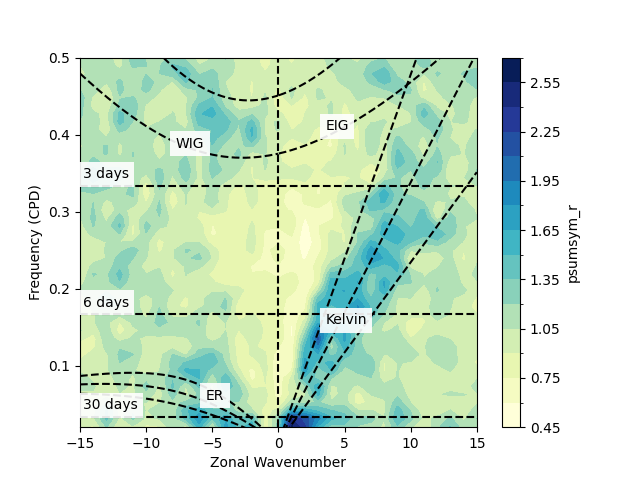Note
Go to the end to download the full example code.
Wheeler-Kiladis Space-Time Spectra#
The Wheeler-Kiladis (WK) Space-Time Spectra is a diagnostic tool used in meteorology to analyze tropical atmospheric waves by decomposing their variability in both wavenumber (space) and frequency (time) domains. It extends traditional Fourier analysis by applying a two-dimensional (2D) spectral decomposition to isolate and characterize different wave modes (e.g., Kelvin waves, Rossby waves, and mixed Rossby-gravity waves) based on their dispersion relations.
Key Features#
Uses symmetrical (eastward/westward) and antisymmetrical (north-south) Fourier transforms to separate wave types.
Compares observed spectra with theoretical dispersion curves of shallow-water waves to identify dominant modes.
Helps distinguish convectively coupled waves (linked to tropical rainfall) from uncoupled waves.
Applications in Meteorology#
Tropical Wave Analysis: Identifies and tracks Kelvin waves, equatorial Rossby waves, and Madden-Julian Oscillation (MJO) signals.
Convective Coupling Studies: Examines how waves interact with tropical convection (e.g., in monsoon systems).
Model Validation: Evaluates whether climate models correctly simulate tropical wave dynamics.
Extreme Weather Prediction: Helps understand precursors to tropical cyclogenesis and organized convection.
See also
Wheeler, M., & Kiladis, G. N. (1999). Convectively Coupled Equatorial Waves: Analysis of Clouds and Temperature in the Wavenumber–Frequency Domain. Journal of the Atmospheric Sciences, 56(3), 374-399. https://journals.ametsoc.org/view/journals/atsc/56/3/1520-0469_1999_056_0374_ccewao_2.0.co_2.xml
Kiladis, G. N., M. C. Wheeler, P. T. Haertel, K. H. Straub, and P. E. Roundy (2009), Convectively coupled equatorial waves, Rev. Geophys., 47, RG2003, doi: https://doi.org/10.1029/2008RG000266
Wheeler, M. C., & Nguyen, H. (2015). TROPICAL METEOROLOGY AND CLIMATE | Equatorial Waves. In Encyclopedia of Atmospheric Sciences (pp. 102–112). Elsevier. https://doi.org/10.1016/B978-0-12-382225-3.00414-X
Yoshikazu Hayashi, A Generalized Method of Resolving Disturbances into Progressive and Retrogressive Waves by Space Fourier and Time Cross-Spectral Analyses, Journal of the Meteorological Society of Japan. Ser. II, 1971, Volume 49, Issue 2, Pages 125-128, Released on J-STAGE May 27, 2008, Online ISSN 2186-9057, Print ISSN 0026-1165, https://doi.org/10.2151/jmsj1965.49.2_125, https://www.jstage.jst.go.jp/article/jmsj1965/49/2/49_2_125/_article/-char/en
The WK method is particularly useful for studying large-scale tropical variability and remains a fundamental tool in tropical meteorology and climate research.
Before proceeding with all the steps, first import some necessary libraries and packages
import xarray as xr
import matplotlib.pyplot as plt
import easyclimate as ecl
The example here is to avoid longer calculations, thus we open the pre-processed result data directly.
Tip
You can download following datasets here: Download olr_smooth_data.nc
data = xr.open_dataset('olr_smooth_data.nc')['olr'].sel(lat = slice(-15, 15))
data
Setting the basic parameters and removing the dominant signal
spd=1
nDayWin=96
nDaySkip=-71
data_dt = ecl.field.equatorial_wave.remove_dominant_signals(data, spd,nDayWin,nDaySkip)
data_dt.isel(time =0).plot.contourf(levels = 21)

<matplotlib.contour.QuadContourSet object at 0x7ff735e15dd0>
Separation of symmetric and asymmetric parts
data_as = ecl.field.equatorial_wave.decompose_symasym(data_dt)
data_as.isel(time = 0).plot.contourf(levels = 21)

<matplotlib.contour.QuadContourSet object at 0x7ff735c99910>
Calculation of spectral coefficients
Drawing asymmetric parts
fig, ax = plt.subplots()
psum.psumanti_r.plot.contourf(ax = ax, levels=21, cmap = 'YlGnBu')
ecl.field.equatorial_wave.draw_wk_anti_analysis()

And drawing symmetric parts
fig, ax = plt.subplots()
psum.psumsym_r.plot.contourf(ax = ax, levels=21, cmap = 'YlGnBu')
ecl.field.equatorial_wave.draw_wk_sym_analysis()

Total running time of the script: (0 minutes 3.826 seconds)